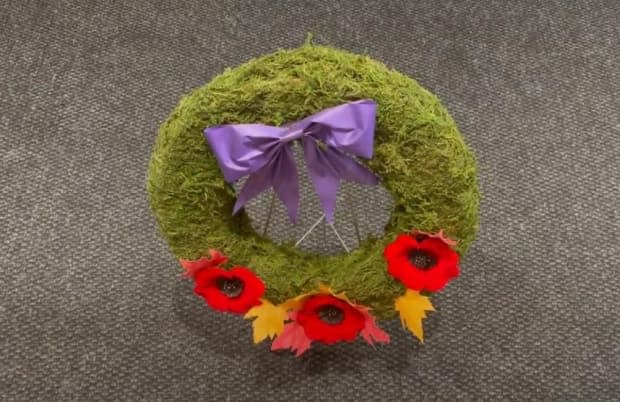This year's Remembrance Day poppies are biodegradable for the 1st time

This year, there's an environmentally friendly take on the poppies worn in the lead-up to Remembrance Day.
For the first time, the Royal Canadian Legion is offering biodegradable poppies, as well as wreaths.
Brian Harris, who leads the legion's poppy campaign in Ontario, said the 2022 symbols of support for veterans are made with cotton velvet, bamboo, non-woven fabric and some string.
"You would be able to tell by just looking at them; the actual composition of it almost looks like it's stamped out of the material," he said. "It's the same colour, but if you look at the back, it's not quite as shiny as poppies were in past."
Previous poppies were made of plastic and felt.
The Royal Canadian Legion is going through residual stock of the plastic poppies before they're completely replaced by their biodegradable counterparts.
"Probably by next year, all the poppies that you'll see out and about will be the new biodegradable ones," Harris said.
LISTEN | Brian Harris gives a breakdown on Windsor Morning of the biodegradable poppy:
Across Canada, 22 million to 25 million poppies — including 50,000 to 100,000 in the Windsor area — are distributed each year, according to Harris.
The move toward a greener poppy comes amid a broader shift away from single-use plastics in Canada. The federal government has set a target of 2030 for the elimination of plastic waste. Next month, a ban on importing or manufacturing some single-use items takes effect.

Karen Wirsig, the program manager for plastics with the advocacy group Environmental Defence, said the switch to biodegradable poppies is a positive one.
A greener option, though, would be for people to reuse their poppy every year, but still contribute to legions' annual fundraiser, she said.
"I get that the legions have used poppies as a way of raising money," she said. "Maybe just reminding people that they have their poppies at home and to donate to veterans would be a way to do that."
Plastic poppies don't weigh much, but still have an impact when they fall off coats and become litter, she said.
"When plastic ends up in nature, it's not even the weight of it that's the problem — it's where does it go. It gets washed into drains, it goes into our lakes, and rivers and oceans, and it really can harm wildlife."
Poppy campaign supports programs for veterans
According to the Royal Canadian Legion, the poppy campaign raises about $20 million annually to support programs for veterans.
This year, the legion is also launching initiatives it says will engage more Canadians in the meaning of remembrance, including a smartphone component.
"You can scan your poppy, and I believe there's 500 different mini-stories of veterans and those who served that you can bring up," said Harris.
"We're also in the third year of our tap tribute, which is if you don't have any money on you, you can tap your credit card or debit card to make a donation."
Harris said digital poppies can be bought online, downloaded and used in your email signature.
Poppies are meant to be worn from sunrise on the last Friday in October until sundown on Nov. 11.


